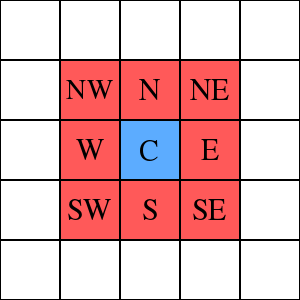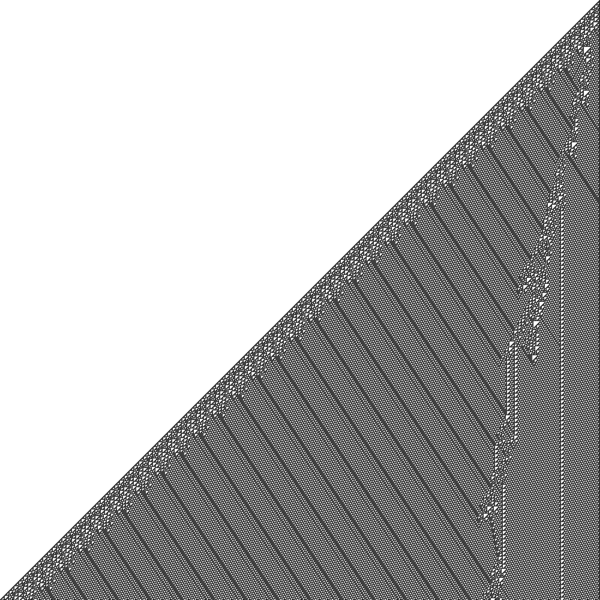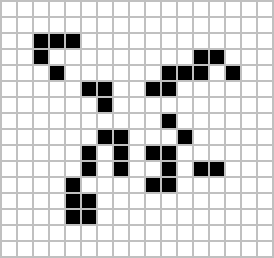Objects in an alien physics
Posted on Thu 04 November 2010 in Rumination
Many of you are no doubt familiar with cellular automata such as Conway's Game of Life. In Conway's Game of Life a world consists of an two dimensional array of cells. Each cell is in either of two states, live or dead, at any particular moment, and its next state is calculated by the application of three basic rules(#1):
- Any live cell with fewer than two or more than three live neighbors dies.
- Any live cell with exactly two or exactly three live neighbors continues to live unchanged.
- Any dead cell with exactly three live neighbors cells will come to life.
A neighbor is any cell in a cell's Moore neighborhood of distance one, as depicted in figure 1.

All patterns of activity you see in Conway's Game of Life are merely the result of the execution of these three very simple rules for each cell in the two-dimensional grid. These rules are, one might say, the most basic physics of the universe of Conway's Game of Life. The rules are such that a great deal of interesting emergent behavior results, but all such behavior can ultimately be understood in terms of those rules.
One interesting consequence that immediately follows from these rules is that there is a maximum velocity of effect from one cell to another. Since any cell can only immediately influence cells in its neighborhood in any give time step (generation), cells further away can only be affected after several generations. This maximum velocity, called the speed of light in the Game of Life community, is equal to one cell per generation. If you recall, in my post a Metaphysics for Coyote, I discussed Briant Cantwell Smith's notion of flex and slop, the loose coupling of the world, that permits parts of the world to act relatively independently of other parts of the world, and which, according to Smith, permits the separation of registrar from registered, subject from object. This maximum speed of effect in Conway's Game of Life may be seen as providing, in limited form, just such a loose coupling between parts of the world.
Further, it is interesting to observe that Conway's Game of Life is a structure of locations each of which has state, and that this view is a discrete analogue to Smith's view of the world as consisting of continuous, particular, and deictic fields, in which "being an individual object is also not, in and of itself, an effective or even salient physical property. No physical attribute holds of an individual, for example, except in virtue of its physical composition…For there are no physical objects." (#2). As was pointed out before, the rules of Conway's Game of Life provide its constitutional physics; everything observed in a Game of Life is the deterministic result of applying these rules to various state distributions on the grid of cells (analogous to locations). In some very real sense, objects are not fundamental because no attribute of any collection of activity holds except in virtue of its composition of cells and their states at various times.
I want to briefly contrast this situation to that frequently taken in modeling and simulation, in which the the targets of simulation are modeled as (more or less) encapsulated objects with properties and behaviors. The following makes this point a little more clear. In Andrew Ilanchinski's massive tome Cellular automata: a discrete universe, Ilanchinski
writes:
Forget for a moment that you know that [figure 2] shows the space-time pattern due to a well defined local deterministic rule, and that the underlying “universe” really consists of nothing but “bits.” Suppose you are told only that this figure represents some sort of “alien physics,” and that you may see as many different samples of this alien world’s behavior as you wish. How are you to make any sense of what is really going on? Noticing that the figure consists of certain particle-like objects sprinkled on a more-or-less static background, the simplest (most natural?) thing for you to do - and your physics training certainly comes in very handy here- is to begin cataloging the various “particles” and their“interactions.” You begin by methodically writing in your journal observations of the form ‘‘There are N particles of size s moving to the left with speed v", [etc.]... At best, you will have a long (and likely still incomplete) list of particles and their interactions. What you almost assuredly will not have, is any idea that the underlying physics really consists of a single -- very simple \~ local deterministic rule that acts on the particles that are the fixed sites of a lattice taking on the values 0 or 1. How different is this alien two-dimensional world from our own?" (#3 page 662).

Such a cataloger-physicist might choose to simulate such a universe by modeling each particle as an object with properties and behaviors, and their interactions by various hypothesized nomothetic laws. But all such particles are merely certain kinds of observed pattern regularities- their object-hood is ephemeral and depend on their being ascribed object-hood by the cataloger #4.

And yet, knowing that the world of cellular automata (and of Conway's Game of Life in particular) is in some essential way object-less, objects are ubiquitously found in them by members of the CA community. Within the Game of Life community, the names for these

objects are frequently quite colorful. Patterns are frequently classified as guns, methuselahs, oscillators, ouffers, spaceships, still lifes, wicks, and (of course) miscellaneous. For those not familiar with the vocabulary, discussions by members of the community can be quite unintelligible. Consider this recent snippet from the conversation that erupted after the announcement by Andrew Wade that he had built an oblique spaceship (and accomplishment described by Adam Goucher as "arguably the single most impressive and important pattern ever devised.“ )
User igblan writes:
The "shoulder" of the construction arm, which fires the four kinds of construction salvo, was deliberately built using "Spartan" Herschel technology, ie using Herschel components constructed solely from blocks, beehives, tubs, boats and eaters. This was in the expectation of minimizing the complexity of slow-salvo construction using a single arm. (Even so, some recent informal work I did showed that the close spacing of eaters in some places would require some synchronized one-off two-glider syntheses using small, one-shot glider splitters and reflectors.) http://conwaylife.com/forums/viewtopic.php?f=2&t=399&p=2327#p2334
So, in a sense what I want to do, going forward, is to make sense out of this apparently contradictory situation in which objects at the most fundamental level of the physics of a world do not exist, but are nonetheless so deeply necessary to a sophisticated understanding of that world.
I end with a keen, if controversial observation from Ilanchinski that very clearly coincides with the philosophical direction in which I have been moving:
The dynamics of complex adaptive systems, in general, and of CA in particular, suggest that (i) most interesting phenomena arise precisely because of an irreducible, coupling between object and environment (so that any distinction between inside and outside is artificial and not, representative of how real systems are fundamentally structured... and (ii) “objects” are really semantic constructs that are functions of the local context within which their existence, or nonexistence, is assigned meaning, rather than independently and objectively existing entities within a system. (p. 697)
It is that sort of universe I imagine.
Notes and References
#1 http://www.conwaylife.com/wiki/index.php?title=Game_of_life)
#2 Smith, Brian C. On the origin of objects, MIT Press, London. 1996
#3 Ilanchinski, Andrew. Cellular automata: a discrete universe, World Scientific Publishing Co. 2001.
#4 I do not have the kind of training in physics to follow Ilanchinski in his speculations (and the speculations of those he cites) about whether the physical universe is indeed a cellular automaton, or not, though some pretty smart people have taken the idea seriously.